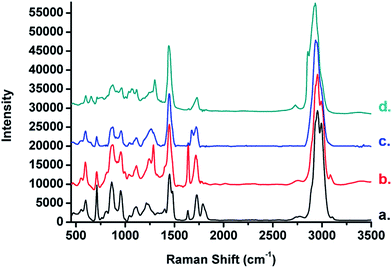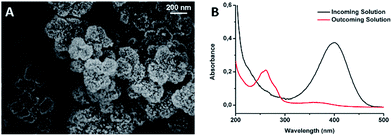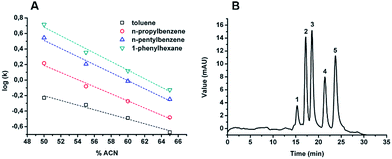Novel in-capillary polymeric monoliths arising from glycerol carbonate methacrylate for flow-through catalytic and chromatographic applications†
Romain Poupart,
Djerir Nour El Houda,
Deena Chellapermal,
Mohamed Guerrouache,
Benjamin Carbonnier* and
Benjamin Le Droumaguet*
Université Paris Est, ICMPE (UMR 7182), CNRS, UPEC, F-94320 Thiais, France. E-mail: ledroumaguet@icmpe.cnrs.fr
First published on 27th January 2016
Abstract
In-capillary reactive polymer monoliths have been prepared from glycerol carbonate methacrylate functional monomers. Following functionalization with suitable ligands and eventually after immobilization of metallic nanoparticles, these materials can be successfully employed as supports for chromatographic applications or microreactors for flow-through catalysis.
Nowadays, the great challenge regarding polymeric monoliths, which relies on the control of their surface properties, has attracted an ever-growing interest in the world of materials chemistry and analytic sciences. This concept notably requires that the functionalization of such porous materials should be fast, versatile, straightforward, as quantitative as possible, simple to perform and achieved under mild experimental conditions. The commonly used strategy relies on the post-polymerization functionalization of reactive interfacial pendant moieties on monoliths. To this purpose, different macroporous materials based on functionalizable monomers have been developed, allowing for facile nucleophilic substitution/addition with organic grafts of interest. Historically, glycidyl methacrylate (GMA) based monoliths were the first macroporous functional materials to be successfully modified with different organic molecules through ring-opening in the presence of amino compounds,1–6 etc.3,7–10 to afford a plethora of surface functionalities. Vinyl benzyl chloride (VBC) based monoliths have also been notably modified by nucleophilic substitution of the chloride in the presence of different amines.7,11 Other reactive monoliths based on 2-vinyl-4,4-dimethylazlactone (VDMA) were successfully used for the immobilization of amine bearing (macro)molecules such as ethylene diamine and cysteamine,12,13 trypsin,14,15 iminodiacetic acid15 or anti-testosterone polyclonal antibodies16 on azlactone pendant moieties for diverse bio-related sensing applications. More recently, porous monolithic micro-sized columns arising from N-acryloxysuccinimide (NAS) have been deeply investigated by our group. They can notably be easily functionalized with a variety of amines.17–19 On top of that, a two-step procedure can also be applied for the efficient grafting of thiol-appended organic (macro)molecules20–23 via photo-initiated thiol-yne, thiol–ene addition or through copper-catalyzed azide–alkyne dipolar cycloaddition (CuAAC) reaction, respectively. Finally, IEM-based porous materials display a high reactivity towards alcohols and amines in the presence of dibutyltin dilaurate (DBTDL) catalyst.24 Unfortunately, isocyanate moieties are highly sensitive to air moisture and, as a consequence, prone to hydrolysis. It is thus rather difficult to store them for long periods of time.
Despite their good reactivity and the numerous chemistries that can be undergone at the surface of such functional monoliths to produce diverse polymeric – from hydrophilic to hydrophobic – interfaces, all these reactive monomers originate from organic reagent precursors. Owing to today's major concerns of scientists for environment, polymers and polymeric materials stemming from renewable resources have gained a tremendous interest.
Herein, we report in this study a novel monolith based on glycerol carbonate methacrylate (GCMA), functional monomer arising from a bio-based precursor, i.e. glycerol. Cyclic carbonates can undergo ring opening in the presence of nucleophilic compounds such as primary amines and eventually carboxylic acids. This may ensure for further easy and straightforward functionalization of the as-obtained porous matrix with organic compounds of interest (chelating molecules or selectors of different nature) and/or metallic nanoparticles (MNPs) for targeted applications such as flow-through catalysis or separation sciences.
The synthetic route followed for the synthesis of the in-capillary monolith is depicted in the Scheme 1.
Prior to the polymerization of the GCMA-based monolith, an activation step, consisting in the grafting of methacrylic functions at the inner wall of the fused silica capillary, was necessary. This notably ensured the tight covalent attachment of the monolith to the inner wall of the 100 μm diameter capillary.
In order to obtain ideal porous characteristics of the GCMA-based monolith in terms of permeability and homogeneity all along the capillary, different polymerization mixtures were assessed. For instance, three different porogenic solvent mixtures were tested, namely toluene/dodecanol: 75/25 and 40/60 or toluene/nonane: 50/50 (v/v) among many others (see Table S1 ESI† for full polymerization mixture composition investigation), as shown in Table 1. In the same way, the GCMA/EGDMA and GCMA/porogenic solvent mixture (w/w) ratios were finely tuned. The micrometer-sized range porosity of such monoliths was demonstrated by mercury intrusion porosimetry on bulk materials that showed a bimodal porous distribution centered on 2.2 μm and 50 nm, respectively. This bimodal distribution was assumed to be likely due to the contribution of each porogenic solvent present in the polymerization mixture. The respective permeability of the as-obtained monolithic columns were calculated using the Darcy law equation (eqn (1)), that measures their capacity to transmit a fluid driven by an imposed pressure drop:
| B0 = (η × L × Q)/(A × ΔP) | (1) |
| Polymerization mixture | % v/v toluene/DOHa | % v/v toluene/C9H20 | % w/w monomers/solvents | % w/w GCMA/EGDMA | B0b (10−14 μm2) |
|---|---|---|---|---|---|
| a DOH: dodecanol.b B0: permeability as calculated by the Darcy law equation. | |||||
| 1 | 75/25 | — | 36.2/33.8 | 34.4/65.6 | 4.31 |
| 2 | — | 50/50 | 36.2/63.8 | 34.4/65.6 | 0.89 |
| 3 | 40/60 | — | 39.2/60.8 | 34.4/65.6 | 1.83 |
The functionalization of the polymer monolithic capillary developed in this work relies on a strategy involving a nucleophilic addition of the pore surface glycerol carbonate functionalities with nucleophilic amino compounds. Indeed, different research groups reported in the past the possibility to easily functionalize such cyclic carbonates with good nucleophiles such as amines,23,24 but also carboxylates.25 Hence, we particularly focused our attention on the immobilization of allylamine at the pore surface of such GCMA-based in-capillary monolith as resulting interfacial alkene functionalities would generate a versatile, easy and straightforward platform for subsequent “click” photo-driven radical thiol–ene reaction26 with chemical thiols of interest. Such a functionalization reaction was monitored by in situ Raman spectroscopy as shown on Fig. 2. The occurrence of the characteristic signal corresponding to the double bond arising from grafted allylamine was immediately noticed on the monolithic capillaries at 1636 cm−1 after functionalization reaction of the GCMA-based materials, when compared to pristine GCMA-based monoliths, while the cyclic carbonate characteristic band at 1800 cm−1 totally vanished.27 Energy dispersive X-ray spectroscopy (EDX, Fig. S1†) corroborated this finding with the appearing of the Kα ray of nitrogen (at 0.392 keV) in the resulting allyl-functionalized monolithic capillary. As already above-mentioned, a subsequent step was necessary to anchor metal chelating or hydrophobic functionalities at the monolith pore surface, depending on the targeted application, i.e. for flow-through catalysis or separation sciences, respectively. To that purpose, a photo-triggered radical thiol–ene addition of either 1-octane thiol or 4-mercaptobutyric acid was envisioned. Again, in situ Raman spectroscopy ascertained the covalent grafting of both organic compounds at the pore surface. Indeed, the total disappearing of the band at 1636 cm−1 was noticed, thus demonstrating the efficiency of both photo-triggered radical thiol–ene “click” coupling reactions. These results (Fig. S1, ESI†) were also confirmed by EDX semi-quantitative analysis that indicated the presence of an important sulfur content in the monoliths after thiol–ene reaction, as showed by the intense sulfur Kα ray at 2.307 keV.
The immobilization of metallic nanoparticles at the surface of such polymer-based monolithic capillaries allows for the production of microreactors that can be applied in flow-through catalytic reactions.22,28 Further immobilization of platinum nanoparticles was thus investigated through the in situ strategy consisting in the initial adsorption of metal cations over carboxyl-decorated monolithic surface and subsequent hydride-mediated reduction of metallic ions into the corresponding nanometals. Experimentally, a 1 wt% platinum salt (PtCl42−) solution in ethanol was percolated through the carboxyl-functionalized GCMA-based capillary, thus allowing for Pt2+ ions pre-concentration at the pore surface of the carboxyl-functionalized monolith. In a second step, platinum nanoparticles (PtNPs) were generated via reduction of Pt2+ ion precursors in the presence of sodium borohydride (NaBH4). SEM investigations onto the PtNPs@in-capillary GCMA-based monolith indicated a homogeneous and dense PtNPs coverage of the –COOH coated pore surface, as shown on Fig. 3A. As polymer-templated/-supported Pt NPs are prone to nitroarenes reduction.29–31 In this context, the possibility to reduce p-nitrophenol (PNP) was investigated in the as-obtained hybrid PtNPs@in-capillary GCMA-based monolith. Upon dynamic loading (flow rate of 2 μL min−1) of a solution of PNP/NaBH4 through the hybrid monolithic capillary, the solution harvested at the capillary outlet was observed to the naked eye. The yellow coloration of the solution loaded at the capillary inlet totally vanished and the obtained colorless solution was analyzed by UV-visible spectrophotometry. The success of the reaction was immediately verified by the total disappearing of the π → π* transition band characteristic of PNP at 400 nm along with the appearing of a new π → π* transition band at higher energy (λ = 260 nm) corresponding to the expected product, i.e. p-aminophenol (PAP).
On the other hand, the separation properties of hydrophobic monolith displaying exposed C8 grafts was investigated by capillary liquid chromatography (nano-LC), as such monoliths should be expected to separate hydrophobic solutes.32 In this study, alkylbenzenes, i.e. toluene, n-propylbenzene, n-pentylbenzene and 1-phenylhexane, were purposely selected as hydrophobic solutes to test the chromatographic properties of such C8-grafted capillary columns. The system was thus assessed in reversed-phase mode conditions eluting with hydro-organic mobile phases constituted of water and increasing acetonitrile (ACN) content while DMF was considered as unretained compound. As observed on Fig. 4A and as expected for a reversed-phase separation mode, the retention of the four alkylbenzenes increased with decreasing acetonitrile content while the elution order was not changed for the different mobile phase compositions tested. A typical chromatogram from such a separation on 20 cm length C8 column when eluting with a mobile phase constituted of ACN/H2O (60/40: v/v) at a flow rate of 0.4 μL min−1 is presented on Fig. 4B. The four analytes were successfully separated with efficiencies of about 50![[thin space (1/6-em)]](https://www.rsc.org/images/entities/char_2009.gif) 000 plates per m, that are in the same order of magnitude than those previously reported elsewhere.33,34 It is worth mentioning that chromatographic conditions used to separate the different hydrophobic analytes were not optimized so as to reduce analysis time, for instance.
000 plates per m, that are in the same order of magnitude than those previously reported elsewhere.33,34 It is worth mentioning that chromatographic conditions used to separate the different hydrophobic analytes were not optimized so as to reduce analysis time, for instance.
In summary, this paper addresses the unprecedented preparation of monolithic columns from GCMA, a reactive functional monomer arising from renewable resources. Further surface modification of the pendant cyclic carbonate with allylamine afforded resulting alkene functionalized monoliths. A successive radical photo-triggered thiol–ene “click” addition allowed for the efficient grafting of 1-octane thiol or mercaptobutyric acid. The full potential of such functional GCMA-based monolith was demonstrated in separation sciences with the resolution of 4 alkylbenzenes on C8-grafted GCMA-based monoliths and flow-through catalysis with the efficient reduction of nitroarene model compound through PtNP-immobilized carboxylic acid-functionalized GCMA-based monoliths.
Acknowledgements
R. Poupart is grateful to UPEC for providing Ph.D funding.Notes and references
- F. Svec and J. M. J. Fréchet, J. Chromatogr. A, 1995, 702, 89–95 CrossRef CAS PubMed.
- Q. Cao, Y. Xu, F. Liu, F. Svec and J. M. J. Fréchet, Anal. Chem., 2010, 82, 7416–7421 CrossRef CAS PubMed.
- Y. Xu, Q. Cao, F. Svec and J. M. J. Fréchet, Anal. Chem., 2010, 82, 3352–3358 CrossRef CAS PubMed.
- Y. Lv, Z. Lin and F. Svec, Analyst, 2012, 137, 4114–4118 RSC.
- E. C. Peters, F. Svec and J. M. J. Fréchet, Adv. Mater., 1997, 9, 630–633 CrossRef CAS.
- Q. Luo, H. Zou, X. Xiao, Z. Guo, L. Kong and X. Mao, J. Chromatogr. A, 2001, 926, 255–264 CrossRef CAS PubMed.
- J. P. Hutchinson, E. F. Hilder, R. A. Shellie, J. A. Smith and P. R. Haddad, Analyst, 2006, 131, 215–221 RSC.
- M. Slater, M. Snauko, F. Svec and J. M. J. Fréchet, Anal. Chem., 2006, 78, 4969–4975 CrossRef CAS PubMed.
- X. Sun, X. He, L. Chen and Y. Zhang, Anal. Bioanal. Chem., 2011, 399, 3407–3413 CrossRef CAS PubMed.
- Y. Ueki, T. Umemura, J. Li, T. Odake and K.-i. Tsunoda, Anal. Chem., 2004, 76, 7007–7012 CrossRef CAS PubMed.
- I. Gusev, X. Huang and C. Horváth, J. Chromatogr. A, 1999, 855, 273–290 CrossRef CAS PubMed.
- D. Connolly, B. Twamley and B. Paull, Chem. Commun., 2010, 46, 2109–2111 RSC.
- P. Floris, B. Twamley, P. Nesterenko, B. Paull and D. Connolly, Microchim. Acta, 2014, 181, 249–256 CrossRef CAS.
- S. Xie, F. Svec and J. M. J. Fréchet, Biotechnol. Bioeng., 1999, 62, 30–35 CrossRef CAS PubMed.
- D. S. Peterson, T. Rohr, F. Svec and J. M. J. Fréchet, Anal. Chem., 2002, 74, 4081–4088 CrossRef CAS PubMed.
- H.-X. Chen, T. Huang and X.-X. Zhang, Talanta, 2009, 78, 259–264 CrossRef CAS PubMed.
- B. Carbonnier, M. Guerrouache, R. Denoyel and M.-C. Millot, J. Sep. Sci., 2007, 30, 3000–3010 CrossRef CAS PubMed.
- M. Guerrouache, B. Carbonnier, C. Vidal-Madjar and M.-C. Millot, J. Chromatogr. A, 2007, 1149, 368–376 CrossRef CAS PubMed.
- M. Guerrouache, M. C. Millot and B. Carbonnier, J. Sep. Sci., 2011, 34, 2271–2278 CAS.
- T. T. H. Dao, M. Guerrouache and B. Carbonnier, Chin. J. Chem., 2012, 30, 2281–2284 CrossRef CAS.
- I. Tijunelyte, J. Babinot, M. Guerrouache, G. Valincius and B. Carbonnier, Polymer, 2012, 53, 29–36 CrossRef CAS.
- R. Poupart, B. Le Droumaguet, M. Guerrouache and B. Carbonnier, Mater. Chem. Phys., 2015, 163, 446–452 CrossRef CAS.
- M. Guerrouache, M.-C. Millot and B. Carbonnier, Macromol. Rapid Commun., 2009, 30, 109–113 CrossRef CAS PubMed.
- Y. Lv, T. C. Hughes, X. Hao, N. K. Hart, S. W. Littler, X. Zhang and T. Tan, Macromol. Rapid Commun., 2010, 31, 1785–1790 CrossRef CAS PubMed.
- M. Ghandi, A. Mostashari, M. Karegar and M. Barzegar, J. Am. Oil Chem. Soc., 2007, 84, 681–685 CrossRef CAS.
- M. Guerrouache, S. Mahouche-Chergui, M. M. Chehimi and B. Carbonnier, Chem. Commun., 2012, 48, 7486–7488 RSC.
- C. C. Huang, C. H. Lin and S. A. Dai, J. Polym. Sci., Part A: Polym. Chem., 2015 DOI:10.1002/pola.27914.
- M. Nandiab and H. Uyama, RSC Adv., 2014, 4, 20847–20855 RSC.
- H. Liu, D. Wan, J. Du and M. Jin, ACS Appl. Mater. Interfaces, 2015, 7, 20885–20892 CAS.
- S. Pandey and S. B. Mishra, Carbohydr. Polym., 2014, 113, 525–531 CrossRef CAS PubMed.
- J.-H. Noh and R. Meijboom, Appl. Catal., A, 2015, 497, 107–120 CrossRef CAS.
- N. Zhang, L. Zhang, X. Qiao, Y. Wang, H. Yana and L. Baia, RSC Adv., 2015, 5, 91436–91440 RSC.
- R. Freitag, J. Chromatogr. A, 2004, 1033, 267–273 CrossRef CAS PubMed.
- C. Aydoğan, J. Chromatogr. A, 2015, 1392, 63–68 CrossRef PubMed.
Footnote |
| † Electronic supplementary information (ESI) available: Experimental informations, Table S1 and Fig. S1. See DOI: 10.1039/c5ra27248c |
| This journal is © The Royal Society of Chemistry 2016 |





